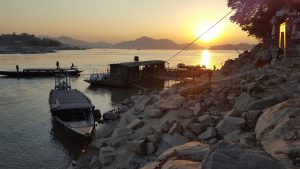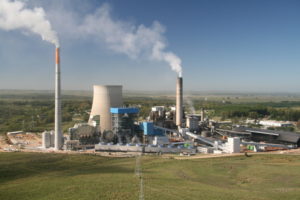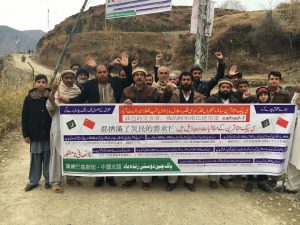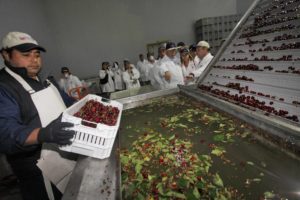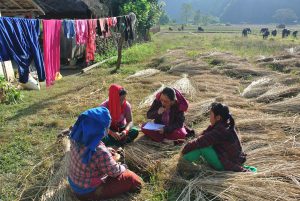Mohammad Saleem and Badar Din have never heard of CPEC but they see plenty of Chinese people around. Their boss is Chinese and they communicate with him through signing as they do not speak the same language. Both men, in their twenties, have travelled from a village in Sehwan in Sindh, to Gwadar to work as labourers at the port site under construction. Even after paying rent for accommodation, meals and transport, they save more than they ever earned in their own village. “There is work for everyone,” says Saleem, who has been able to buy a solar light and a fan for his family.
This is what Prime Minister Nawaz Sharif has said all along, that the China-Pakistan Economic Corridor (CPEC), a vital part of China’s Belt and Road Initiative, will open up vast employment opportunities for Pakistanis.
Slicing through the Himalayas, the 3,000 kilometre, USD 62 billion corridor from Kashgar in western China traverses disputed territories, plains and deserts to reach Gwadar in Pakistan on the shores of the Arabian sea.
On the way, China will fund and build a myriad infrastructure projects, including road and railway networks, and power plants. More than 30,000 Pakistanis are working on various corridor projects and the Planning Commission predicts that 700,000 to 800,000 jobs will be created between now and 2030.

“I have my concerns because of a complete lack of transparency,” Akbar Zaidi, one of Pakistan’s political economists, told thethirdpole.net. “If it’s so fabulous, tell us the terms of investments. Why not be upfront about it? I cannot definitively say whether CPEC is good, bad or a disaster for Pakistan.”
In a lecture Zaidi delivered in Kolkata earlier this month, he said that CPEC seemed more like a Chinese project; the benefits are heavily loaded towards China, with Pakistan benefiting because it happens to be “part of the geographical terrain”.
He also raised concerns over the massive loans involved, citing Sri Lanka and Tajikistan’s heavy borrowing from China. In 2011, Tajikistan had to cede 1% of its territory to China in exchange for unpaid loans. Sri Lanka will give away 80% of its share of the Hambantota deep sea port to China for the next 99 years, in exchange for USD 1.1 billion in debt relief.
Disrupting the flow
There are even sharper concerns about the environmental impact. Michael Kugelman, deputy director and senior associate for south Asia with the Woodrow Wilson Center’s Asia Program, foresees a “wide variety of factors ranging from the use of emissions-belching technologies to the clearing or even destruction of agricultural farmland”. He is particularly concerned about the use of coal, environmentally-damaging technologies and the heavy consumption of water – a prerequisite for such intensive development and construction.
Along with the use of dirty fuel, Vaqar Zakaria, managing director of environmental consultancy firm Hagler Bailly Pakistan, is concerned about the lack of conversation around the impacts of hydropower projects on river ecosystems.
China has promised to finance and build the USD 50 billion five-dam Indus Cascade to generate more than 22,000 MW. The cascade could stop the flow of silt – the lifeline of agriculture downstream – as well as drastically reduce the flow of water in the Indus, especially affecting downstream areas like Pakistan’s Sindh province. Thousands of people will be displaced.
See: Indus Cascade: a Himalayan blunder
“It is possible that the flow of silt may be significantly affected, but what the actual impacts will be for agriculture are unknown,” says Hassaan F. Khan, a researcher at the University of Massachusetts studying the impacts of climate change on water resources in South Asia.

“Future changes in climate are expected to increase the variability of flow on the Indus and change the timing of the peak flow,” says Khan, adding that almost 80% of the flow in the Indus occurs between June and August, but is expected to shift to April and May. That could have a very disruptive impact on water use downstream, especially for farmers.
“The most effective way to limit the economic impacts of this increased variability and uncertainty in flow is to manage the river,” said Khan. “That means storing some of the water when it is available and releasing it later when farmers need it.”
Pakistan has relatively little ability to manage the flow. “More upstream storage can provide the ability to adapt to changes in the flow on the Indus, both now and in the future,” says Khan.
Mahmood Akhtar Cheema, country representative of the International Union for Conservation of Nature (IUCN), is worried that some CPEC projects passing through the mountainous terrain will disturb the fragile ecosystem.
“The need for wildlife corridors must be underscored [and attention must be paid to] the gradient when roads are being carved to minimize landslides.” Giving the example of the once-endangered Markhor and Ibex populations, Cheema says that a little foresight now will save the country from huge environmental losses later.
In Khyber Pakhtunkhwa province, where the provincial government has started an afforestation campaign, more than 54,000 trees have already been chopped down to make way for the CPEC road network.
Unsustainable development?
So far, the government has not revealed whether any measures have been taken to ensure sustainable development, or if there is an enhanced environmental monitoring and reporting plan.
“Since the environment became a provincial matter, I have doubts about the technical capacity of environmental protection agencies to carry out sound EIAs,” says Cheema, adding that the ecological footprint of this project is unclear from the various reports he has seen.
IUCN has just started a dialogue with various stakeholders, including the government, on the environmental impact of CPEC. It is important that the government engages with organisations like IUCN to provide technical oversight on a continuous basis, he says. “While all EIAs should have been done before a project begins, it’s not too late.”
Academia and think tanks needed to come up with “robust environmental impact analyses on a project-by-project basis”, says Adil Najam, dean of the Fredrick S. Pardee School of Global Studies at Boston University.
Najam emphasises the need for the key regulators – including federal and provincial environmental protection agencies, and the climate ministry – to carry out independent EIAs, and for the government to then act on them at the design phase so that the best possible technology and standards are used for each project.
“If we do that, I think the overall impact can be economically and environmentally beneficial,” says Najam. If not “we will lament the mistakes of omission in ten and twenty years.”
While investment in infrastructure is not only important but necessary, Najam emphasised that it must be “sustainable” and helps the country “leapfrog to a higher standard”.
“Mass transport is a very important – so is rail and highway connectivity – but the question is ‘how is it done’,” says Najam. “If sustainability – economic as well as environmental – is a key element of the design then these can be excellent investments. If ignored, then it can be catastrophic.”
Cloak of opacity
Because everything linked to CPEC is shrouded under a cloak of opacity, both Cheema and Kugelman said it is difficult to know if there are sufficient environmental protective measures in place.
In addition, Zakaria is not sure whether the government has thought of the secondary impacts of development-related projects, which can be significant.
“The social and cultural impacts are likely to be of much higher significance, such as non-inclusive development in Gwadar and Thar, building the Karakoram Highway, and loss of environmental values in Gilgit-Baltistan region. Changes in access change the physical and social landscape,” he says.
CPEC should be thought of as a design exercise,” says Najam. “A series of decisions to be made, and each of these decisions needs to be evaluated – and then regulated – on the principles of environmental sustainability.”
![<p>Graffiti celebrates CPEC on the walls of Pakistan [image by: Zofeen T Ebrahim]</p>](https://dialogue.earth/content/uploads/2017/05/CPEC-300x200.jpg)

